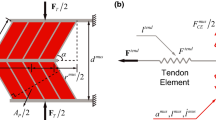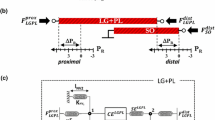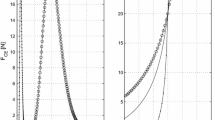Abstract
The aim of this study was to investigate the influence of changing elastic properties of tendon and aponeuroses on force production and muscle geometry. A three-dimensional, structural, continuum mechanics model of the cat medial gastrocnemius was used for this purpose. Increasing compliance in tendon and aponeuroses caused a decrease in the peak isometric force and a shift of the force–length relationship to the right of the length axis (i.e. toward greater muscle lengths). This result can be explained with the stability condition of the force–length relationship which produced a history dependence of force production that is conceptually in agreement with experimental observations.







Similar content being viewed by others
References
Chadwick P (1999) Continuum mechanics concise theory and problems. Dover Publications, New York
Corr D, Herzog W (2005) Force recovery following activated shortening in whole skeletal muscle: transient and steady-state aspects of force depression. J Appl Phys 99:252–260. doi:10.1152/japplphysiol.00509
Edman K, Elzinga G, Noble M (1982) Residual force enhancement after stretch of contracting frog single muscle fibers. J Gen Physiol 80:769–784
Epstein M, Herzog W (1998) Theoretical models of skeletal muscle. Wiley, Chichester
Epstein M, Herzog W (2003) Aspects of skeletal muscle modelling. Proc R Soc 358:1445–1452. doi:10.1098/rstb.2003.1344
Fernandez JW, Mithraratne P, Thrupp SF, Tawhai MH, Hunter PJ (2002) Anatomically based geometric modelling of the musculo-skeletal system and other organs. Biomech Model Mechanobiol 2:139–155. doi:10.1007/s10237-003-0036-1
Gans C, Bock CW (1965) The functional significance of muscle architecture: a theoretical analysis. Ergebn Anat Entw Gesch 38:115–142
Gielen AWJ, Oomens CWJ, Bovendeerd PHM, Arts T, Janssen JD (2000) A finite element approach for skeletal muscle using a distributed moment model of contraction. Comp Meth Biomech Biomed Eng 3:231–244
Gordon AM, Huxley AF, Julian FJ (1966) The variation in isometric tension with sarcomere length in vertebrate muscle fibres. J Physiol 184:170–192
Griffiths RI (1987) Ultrasound transit time gives direct measurement of muscle fiber length in vivo. J Neurosci Meth 21:159–165
Herzog W (2005) Force enhancement following stretching of activated muscle: critical review and proposal for mechanisms. Med Biol Eng Comput 43:173–180. doi:10.1007/BF02345951
Hill A (1938) The heat of shortening and the dynamic constants of muscle. Proc R Soc 126:136–195
Hunter PJ, Smaill BH (1988) The analysis of cardiac function: a continnum approach. Prog Biophys Mol Biol, pp 101–164
Huxley A (1957) Muscle structure and theories of contraction. Prog Biophys Biophys Chem 7:255–318
Kaya M, Carvalho W, Leonard T, Herzog W (2002) Estimation of cat medial gastrocnemius fascicles lengths during dynamic contractions. J Biomech 35:893–902
Lemos RR, Epstein M, Herzog W, Wyvill B (2004) A framework for structured modeling of skeletal muscle. Comp Meth Biomech Biomed Eng 7:305–317. doi:10.1080/10255840412331317398
Lieber RL, Fridén J (2000) Functional and clinical significance of skeletal muscle architecture. Muscle Nerve 23:1647–1666. doi:10.1002/1097-4598(200011)23:11<1647::AID-MUS1>3.0.CO;2-M
Maurel W, Wu Y, Thalmann NM, Thalmann D (1998) Biomechanical models for soft tissue simulation. Springer, Berlin
Ogden RW (1984) Non-linear elastic deformations. Dover Publications, New York
Oomens CWJ, Maenhout M, van Oijen CH, Drost MR, Baaijens FP (2003) Finite element modelling of contracting skeletal muscle. Proc R Soc 358:1453–1460. doi:10.1098/rstb.2003.1345
Sasaki N, Odajima S (1996) Elongation mechanism of collagen fibrils and force–strain relations of tendon at each level of structural hierarchy. J Biomech 29:1131–1136
Schachar R, Herzog W, Leonard T (2002) Force enhancement above the initial isometric force on the descending limb of the force–length relationship. J Biomech 35:1299–1306
Schroeder WJ, Avila LS, Hoffman W (2000) Visualizing with vtk: a tutorial. IEEE Comput Graph Appl 20(5):20–27
Scott SH, Loeb GE (1995) Mechanical properties of aponeurosis and tendon of the cat soleus muscle during whole muscle isometric contractions. J Morphol 224:73–86. doi:10.1002/jmor.1052240109
Stouffer DC, Butler DL, Hosny D (1985) The relationship between crimp pattern and mechanical response of human patellar tendon-bone units. J Biomech Eng 107:158–165
Winters JM, Stark L (1987) Muscle models: what is gained and what is lost by varying model complexity. Biol Cybern 55:403–420
Wu JZ, Herzog W (1999) Modelling concentric contraction of muscle using an improved cross-bridge model. J Biomech 32:837–848
Yucesoy CA, Koopman BHFJM, Huijing PA, Grootenboer HJ (2002) Three-dimensional finite element modeling of skeletal muscle using a two-domain approach: linked fiber-matrix mesh model. J Biomech 35(9):1253–1262
Zahalak G (1981) A distribution-moment approximation for kinetic theories of muscular contraction. Math Biosci 55:89–114
Acknowledgments
This work was supported in part by CAPES-Brazil, University of Caxias do Sul, FAPERGS, University of Calgary, NSERC of Canada, and The Canada Research Chair Programme.
Author information
Authors and Affiliations
Corresponding author
Rights and permissions
About this article
Cite this article
Lemos, R.R., Epstein, M. & Herzog, W. Modeling of skeletal muscle: the influence of tendon and aponeuroses compliance on the force–length relationship. Med Bio Eng Comput 46, 23–32 (2008). https://doi.org/10.1007/s11517-007-0259-x
Received:
Accepted:
Published:
Issue Date:
DOI: https://doi.org/10.1007/s11517-007-0259-x




